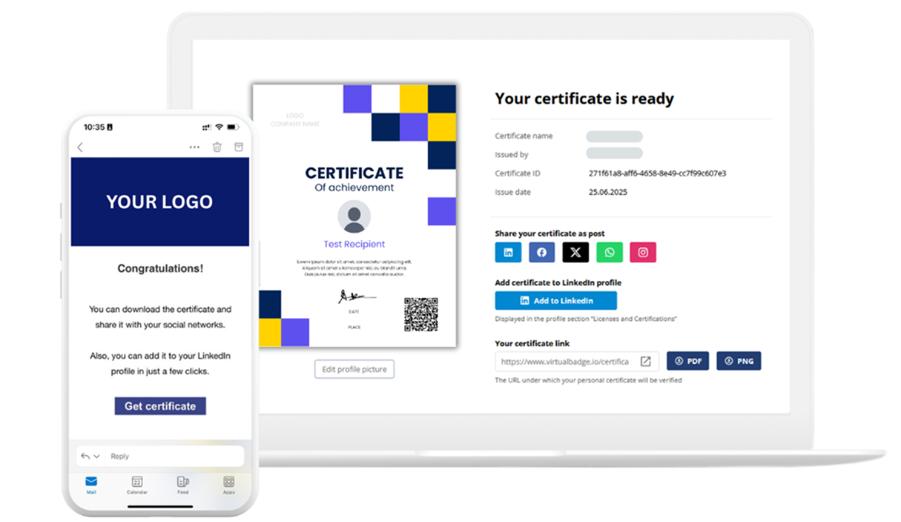No user accounts required for your recipients -
Existing certificates and badges always stay valid


Building credibility through digital certificates and authentic social proof



Trust has become a digital currency. Especially on social media, where anyone can present themselves as an expert or offer educational programs, credibility is hard to earn and easy to lose.
For educational providers, this challenge is real. Whether you run a university course, a first aid training center, or a professional certification program, your reputation depends on how your learners and graduates talk about you online.
But here's the good news: Digital certificates and badges offer a powerful way to create trust, not by talking about your brand, but by letting your learners do it for you. When someone proudly shares their certificate on LinkedIn or Instagram, they aren’t just showing off; they’re vouching for your quality.
In this article, we’ll explore how verifiable certificates can improve trust and visibility across social media, and why they’re becoming essential in modern education marketing.
In the digital world, trust is built through signals, not personal interactions. We rarely meet people face-to-face, so we rely on what is visible, shareable and endorsed by others.
One of the most powerful signals is social proof. It is the psychological principle that says: If others trust it, so can I. On social media, this translates to actions like:
However, not every form of proof is equally effective. A plain certificate in PDF format, sent by email and never shared, does not contribute to public trust. It stays private, invisible and unverifiable.
In short, authenticity builds trust, and digital credentials make authenticity visible. This is especially important in the education sector, where credibility is essential and competition is high.
Providers who understand this dynamic are already using digital certificates as part of their trust-building strategy, increasing both credibility and online visibility.
Digital credentials are not just a modern replacement for paper certificates. They are strategic tools for communication, validation and visibility.
Unlike static PDFs, digital badges and certificates can contain structured metadata, such as:

This information is embedded and linked to a public validation page, allowing anyone who clicks on the certificate to immediately verify its authenticity. This adds a layer of security and transparency that is missing from traditional formats.
Another major advantage is tamper protection. Once issued, these certificates cannot be altered by the recipient. That creates a sense of integrity and shows that your organization takes quality control seriously.
Digital certificates also create value beyond the initial learning experience. They are built for sharing, optimized for visibility and directly contribute to your brand’s reputation. Every share becomes a micro-endorsement, helping to amplify your reach and attract new participants through trust.
If you're looking to understand the full technical value of these credentials, the article: Digital Badges Build Trust: Verifiable Credentials Explained offers a deeper insight into how they work and why they are so powerful.
Social media thrives on stories and signals. Every post, like and share is a public gesture that influences perception. This is where digital certificates can become highly effective trust signals, especially when shared by learners themselves.
Why are shared certificates so powerful?
When someone shares a certificate on LinkedIn, their network sees not just what they achieved but who helped them get there. That builds trust for your program.
A good example of this in action is the case of OMR Education, which transformed its certificate process with Virtualbadge.io. By enabling automated certificate issuance and seamless sharing options, OMR increased visibility, reduced administrative workload and strengthened its reputation as a modern education provider. The full story is available here:
How OMR Education Transformed Its Certificate Issuance
These shared certificates create an ongoing feedback loop. It’s not just about completing a course. It’s about being part of a community that values and validates learning.
It is not enough to issue certificates. To build real trust and visibility, they must be designed, delivered and shared in the right way. Here are some key principles that help transform certificates into authentic trust signals on social media:
1. Design for credibility
A well-designed certificate reflects the quality of your program. Focus on:
2. Make sharing easy
Learners are more likely to share if the process is effortless. Choose a platform that offers:

3. Encourage the right moment to share
Timing matters. Prompt learners to share their certificate:
4. Track and improve
Use metrics to evaluate the success of your certificate strategy:
A deeper dive into these techniques can be found in the article Turn Learners into Promoters with Shareable Certificates, which outlines best practices for encouraging certificate sharing and maximizing impact.
Trust is everything — and digital certificates are more than just proof of participation. They are public signals of credibility, especially when shared on social media.
Educational providers who adopt modern, verifiable credentials position themselves as transparent, learner-focused and forward-thinking. They not only strengthen relationships with their current audience but also attract new participants through the power of visible success.
Key takeaways:
The opportunity is clear. By integrating shareable, verifiable credentials into your program, you move beyond certification and into strategic trust building.
Ready to build trust with every certificate you send?
Book your free demo and we show you how easy it is to turn your learners into your strongest ambassadors.
* You can find the organisation ID in the URL when you access your LinkedIn Company page as an admin.


Marketing
Oct 22, 2025
5 min
Use Virtualbadge.io to design and send digital certificates that create trust - in less than 10 minutes.